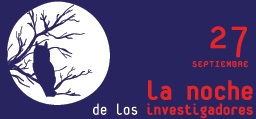IMDEA Networks

Noche de los Investigadores 2013 – La Ciencia del Salón de tu Casa
29 Octubre 2013

Espectáculo insólito: 15 investigadores de los institutos IMDEA aceptaron convertirse en actores por unas horas, para explicarnos la ciencia que se esconde en objetos tan cotidianos como los que podemos encontrar en el salón de nuestra casa.
El pasado viernes 27 de septiembre, en el Espacio Fundación Telefónica de Madrid, entre las 18:00 y las 21:00 h., pudimos disfrutar en directo de un espectáculo insólito: quince investigadores se convirtieron en actores, para explicarnos lo importante que es para todos nosotros la investigación, que termina convirtiéndose en un nuevo material como el grafeno, unas zapatillas deportivas, un teléfono móvil, un ordenador, una botella de agua, la energía que consumimos en nuestras casas, la red WiFi o el software que nos permiten enviar un mensaje o consultar una página web, o lo que cada día comemos.
Organizada por los Institutos Madrileños de Estudios Avanzados (IMDEA), esta actividad fue una de las 22 con las que este año han participado 19 instituciones científicas madrileñas en el proyecto europeo La Noche de los Investigadores. Este proyecto está coordinado por la Fundación madri+d y promovido por la Consejería de Educación, Juventud y Deporte.
Los casi 200 asistentes que completaron el aforo del salón de actos del Espacio Fundación Telefónica en apenas diez minutos, pudieron escuchar a los maestros de ceremonias —José Manuel Torralba e Ignacio Martín Bragado (investigadores del Instituto IMDEA Materiales, acompañados de Manuel Carro (Instituto IMDEA Software)— bromeando sobre la importancia de sus respectivos trabajos y presentando a sus colegas.
El primero, Rodolfo Miranda, director del Instituto IMDEA Nanociencia, hablo de que el cuerpo humano es el mejor ejemplo de Nanociencia y de lo apasionante que es trabajar con átomos y descubrir que un mismo material tiene propiedades muy diferentes si se utiliza en unidades tan pequeñas como la millonésima parte de un milímetro.
Gracias a las tres investigadoras del Instituto IMDEA Agua —Amor Larrosa, María Leal y María Virtudes Martínez— pudimos conocer el ciclo completo del agua y saber que existen bacterias que depuran aguas residuales y a la vez, producen energía eléctrica. Para explicarlo utilizaron un ejemplo muy gráfico: es como si nosotros nos comiéramos un bocadillo y al hacerlo produjésemos tanta energía que nos sobrara y la desprendiésemos en forma de luz.
Guillermo Reglero, director del Instituto IMDEA Alimentación, y dos de sus investigadores, Viviana Loria Kohen y Francesco Visioli, nos recordaron que comer, además de ser imprescindible y un placer, tiene repercusiones directas sobre nuestra salud. Nos mostraron que el genoma de los individuos interactúa con los alimentos y éstos a su vez con el genoma, de forma tal que consumir determinados nutrientes puede beneficiarnos o perjudicarnos.
José Manuel Torralba nos enseñó que el primer material creado por el hombre fue la arcilla cocida y que a ésta le siguieron otros muchos que han revolucionado nuestra vida. Algunos de estos nuevos materiales la han revolucionado y también la han hecho más cara, de tal manera que si comparamos lo que cuesta un kilo del Ferrari de Fernando Alonso y, por ejemplo, uno de zapatillas deportivas, resulta que el primero ¡es más barato! Por su parte, Ignacio Martín continuó remarcando la importancia de la Ciencia de Materiales en el campo concreto de la Microelectrónica, utilizando para ello un móvil. También comentó el ahorro de costes que conlleva sustituir pruebas físicas por simulaciones de ordenador a la hora de testar materiales.
Los investigadores del Instituto IMDEA Software, Manuel Carro, César Kunz, Julián Samborski Forlese y Carolina Inés Dania, esta última vía Skype desde Nueva York, nos convencieron de que el software está en prácticamente todo. Desde un coche, máquina equipada con un cada vez más sofisticado software, que se puede modificar o reparar simplemente cambiando dicho software; hasta el doble captcha (caracteres que el usuario debe introducir a partir de una imagen distorsionada), que ayuda a digitalizar libros antiguos y, a la vez, a que el sistema compruebe que no eres un robot; pasando por la seguridad del tráfico en la red, que utiliza técnicas de encriptación, como las de los espías; hasta los avances en la interpretación automática de imágenes y voz, que permiten, por ejemplo, que Facebook identifique y etiquete automáticamente fotografías.
Vincenzo Mancuso, del Instituto IMDEA Networks, nos mostró su interesante trabajo sobre redes inalámbricas y protocolos de red de bajo consumo. Utilizó para hacerlo un ejemplo muy ilustrativo, comparando lo que le ocurre a la red cuando a ella llega de forma simultánea información de muy diversos orígenes, con lo que ocurre cuando varias personas tiran a la vez unos dados y algunos de ellos obtienen la misma puntuación. Él investiga para que cuando esto ocurra, la red no se colapse.
Terminó el desfile de «actores por un día» con el investigador del Instituto IMDEA Energía Jorn K. Gruber. Con un saco de carbón, una placa fotovoltáica y una factura de la luz, nos enseñó lo importante que es para todos intentar producir energía de la forma menos contaminante posible. Es cierto que ahora pagamos más por ello, pero también lo es que la investigación está ayudando a reducir el coste de las denominadas energías limpias.
Tras la ciencia, vino el arte en forma de canción. Rodolfo Miranda a la guitarra acústica y voz, Ignacio Martín Bragado al teclado y Manuel Carro a la guitarra española, acompañados por Raquel Moreno en los coros, interpretaron Cuerpo de Ola, de Hilario Camacho. Con ello, demostraron que los científicos son como el resto y también tienen aficiones, además de la de pasarse horas y horas trabajando.
La sorpresa que cundió entre el público ante el alarde artístico de los investigadores, no impidió que, terminada la canción, muchos de los asistentes quisieran hacer preguntas. Desde por qué habían elegido ser investigadores, hasta si es cierto que el grafeno va a revolucionar el mundo, pasando por la pregunta más graciosa de todas «¿Te han dicho alguna vez que te pareces a Sheldon Cooper, el protagonista de Big Bang Theory?»
De las respuestas, lo que más llamó la atención fue que algunas hechas al especialista en Energía eran respondidas por los que se dedican a los materiales, las hechas a estos, por el investigador de Nanociencia o los de Software, y así… Con ello, los investigadores demostraron que sus áreas científicas están muy relacionadas, y que el avance en una de ellas produce efectos positivos en el resto. Y por si a alguien le interesa, sí, a más de uno le habían dicho ya que se parecía a Sheldon Cooper.
Bromas aparte, en las tres horas de La Ciencia del Salón de tu Casa, quince investigadores de los institutos IMDEA fueron capaces de convencernos de que su labor es fundamental para nosotros porque, sin ella, los objetos más cotidianos de nuestro entorno no existirían. En definitiva, nos demostraron que con su trabajo diario hacen nuestra vida mejor, y con su trabajo de esa tarde, además, más divertida.



Comentarios recientes